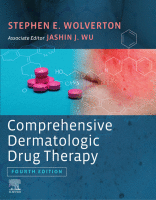Physical Address
304 North Cardinal St.
Dorchester Center, MA 02124

You’re Reading a Preview Become a Clinical Tree membership for Full access and enjoy Unlimited articles Become membership If you are a member. Log in here

Section 1— Pharmacology basic science Section 2— Clinical use Section 3— Severe adverse effects Section 4— Less serious adverse effects Section 5— Drug safety monitoring Section 6— Drug interactions ( see also Appendix 2) Section 7— Miscellaneous issues Section 1—Pharmacology…

Questions Q70.1 How does the relatively high body surface area-to-body volume ratio in infants relate to a relatively high risk of complications from topical medications? (Pg. 768) Q70.2 What are (1) some of the important barriers to compliance in children,…

Questions Q69.1 What are several of the driving forces for the recent increase in compounding in all of medicine? (Pg. 759) Q69.2 How are compounded preparations regulated compared with manufactured products? (Pg. 760) Q69.3 What is meant by the ‘compounding…

Questions Q68.1 What are some of the important medical benefits (for the patient) from a truly informed consent process? (Pg. 754) Q68.2 What are important differences between ‘express’ consent and ‘implied’ consent? (Pg. 754) Q68.3 What are some malpractice and…

Questions Q67.1 Which drugs or drug groups most commonly induce the drug reaction with eosinophilia and systemic symptoms (DRESS)? (Pg. 743) Q67.2 Which anticonvulsants have the potential to cause DRESS; to which category do all but one of these anticonvulsants…

Questions Q66.1 What are several drugs with a narrow therapeutic index, which increases the likelihood of relatively serious drug interactions? (Pg. 726) Q66.2 Which drugs are highly protein bound, increasing the likelihood of significant increases in free drug concentrations, when…

Questions Q65.1 How did the 2015 Pregnancy and Lactation Labeling Rule change the US Food and Drug Administration (FDA) format of drug labeling? ( Pg. 711 ) Q65.2 What are five general concerns all physicians should consider when prescribing drugs…

Questions Q64.1 How can clinicians establish drug causation for all drug adverse effects, including the possibility of drug-induced malignancy? (Pg. 701) Q64.2 What are the pros and cons of using the s urveillance e pidemiology and e nd r esults…

Questions Q63.1 What are two enzymes for which baseline testing serves to predict patients at risk for hematologic toxicity from drugs commonly used in dermatology? (Pgs. 690, 694, 695) Q63.2 What are some of the mechanisms by which hydroxylamine metabolites…